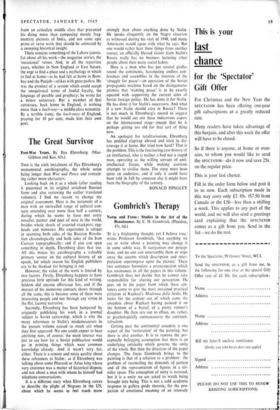Gombrich's Therapy
'IT is a frightening thought, yet I believe true,' writes Professor Gombrich, 'that anything we say or write about a painting may change it in some subtle way. It reorganises our percep- tions, and no one can unscramble them or wipe away the accents which description and inter- pretation superimpose upon the picture.' These two sentences formulate a preoccupation which has resonances in all the papers in this volume. Gombrich does not decide that he cannot take responsibility for altering our perception. He goes on in the paper from which these sen- tences come to give the most sustained practical criticism of Raphael's Madonna della Sedia. He looks for the context out of which came the anecdote about Raphael having painted it on the bottom of a barrel, of a pretty vintner's daughter. He then sets out to efface, or, rather, to psychologically outmanoeuvre the sentimen- talisation.
Getting past the sentimental anecdote is one aspect of the 'restoration' of the painting, but there is also another. It is to remove the per- ceptually befogging assumption that there is an underlying entelechy which governs the unity of the whole. But then the direction of the paper changes. The focus Gombrich brings to the painting is that of a solution to a problem: the problem of reconciling the demands of pattern and of the representation of figures in a cir- cular space. The conception of unity is restored, but it is a unity we are asked to watch being brought into being. This is not a cold academic response to gallery guide rhetoric, for the pro- jection of emotional meaning of an intensely
.rsonal kind is also reintroduced toward the of the paper, but by then Gombrich's - apy has worked and we can be handed back to the rhetorical guide with our perceptions less vulnerably organised.
This reorganisation of our perceptions, and those of artists, preoccupies Gombrich in a Ember of ways which are not related to de- ,ailed criticism of particular works; for instance, ale effect of pre-existent ideas of art, or categories of kinds of painting, on how the artist sets about his work, in particular the effect of classical notions of art on Renaissance practice. He suggests, for instance, that some passages of Ohiberti's commentaries and some aspects of Ghiberti's actual treatment of figures may reflect 'personal attempt by the fifteenth-century Florentine sculptor to identify himself as a Ai odern Lysippus, who, according to Pliny, intro- aced an elongation of the figure into ancient Lrail is the emergence of the idea of the pro- eek sculpture. But more important than the , toess of art, easily available in texts from iitiquity, leading the artist to Work and see his rk in a new way. Here we are in the 'Art and Illusion' segment of Gombrich's work. One of the problems raised Concerns the relation between the interest and tribe of a painting, on the one hand, and the achievement of the artist in transcending some "Idler approximation to reality, on the other. fo ti rmulae and gain a closer approximation to or Gombrich, the artists who transcend earlier realism are, I take it, like the scientists who criticise some older theory, overcome some earlier presupposition.
But when an artist has done this, does this mean that the overcoming of past limitations is part of the interest of his work as a work of art? Pre- iiimably so. But if this is so, do we have to com- pare earlier and later work, or the schema with its Correction to see and feel this achievement as part of the work, or is the artist's discovery also in some way enacted in the structure of the work, the sense of the schema sustained as well as 4ranscended? These problems come to life with some vividness in any attempt to understand the major artists of the first half of the fifteenth century in Florence, in the context of which Gombrich discusses the re-emergence of the artistic idea of progress.
The most sharply polemical paper in the volume is that which gives it its title, 'Norm and Form.' ,:liere Gombrich is concerned with the ready device of art historians of dividing things into two categories like classical and baroque. He points out in an immensely valuable early section how terms like baroque, rococo and gothic were all originally terms meaning non- classical. He also points out how the same passage in Vitruvius against frivolous irrational decoration tends to be cited at the consecration of each of these notions, and that these notions were originally used for normative criticism rather than formalistic classification.
Gombrich's aim here is not simply demolition, but the restoration of concepts like 'classical' on a more rational basis. And it is the very procedures he attacks, in particular some of WOIffiin's, which he provokes one into redefining in a more con-. trollable form.
The publication of this volume, with superb papers going back over the last fifteen years, is a reminder that it is thanks to Gombrich that the student of art history in this country is offered a pattern of art historical study with a theoretical and moral dimension, akin to the critical study of literature.
MICHAEL PODRO































 Previous page
Previous page